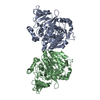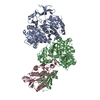+ Open data
Open data
- Basic information
Basic information
| Entry |  | |||||||||||||||
|---|---|---|---|---|---|---|---|---|---|---|---|---|---|---|---|---|
| Title | Cryo-EM structure of Acetyl-coenzyme A synthetase (AcsA) dimer | |||||||||||||||
 Map data Map data | ||||||||||||||||
 Sample Sample |
| |||||||||||||||
 Keywords Keywords | Ac-CoA synthetase AcsA / acetate switch / GCN5-related N-acetyltransferase AcuA / BIOSYNTHETIC PROTEIN | |||||||||||||||
| Function / homology |  Function and homology information Function and homology informationacetate-CoA ligase / acetate-CoA ligase activity / acetyl-CoA biosynthetic process / membrane raft / ATP binding / metal ion binding / plasma membrane / cytosol Similarity search - Function | |||||||||||||||
| Biological species |  | |||||||||||||||
| Method | single particle reconstruction / cryo EM / Resolution: 2.89 Å | |||||||||||||||
 Authors Authors | Zheng LJ / Du Y / Bange G | |||||||||||||||
| Funding support |  Germany, Germany,  United Kingdom, 4 items United Kingdom, 4 items
| |||||||||||||||
 Citation Citation |  Journal: Nat Commun / Year: 2025 Journal: Nat Commun / Year: 2025Title: Regulation of acetyl-CoA biosynthesis via an intertwined acetyl-CoA synthetase/acetyltransferase complex. Authors: Liujuan Zheng / Yifei Du / Wieland Steinchen / Mathias Girbig / Frank Abendroth / Ekaterina Jalomo-Khayrova / Patricia Bedrunka / Isabelle Bekeredjian-Ding / Christopher-Nils Mais / Georg K ...Authors: Liujuan Zheng / Yifei Du / Wieland Steinchen / Mathias Girbig / Frank Abendroth / Ekaterina Jalomo-Khayrova / Patricia Bedrunka / Isabelle Bekeredjian-Ding / Christopher-Nils Mais / Georg K A Hochberg / Johannes Freitag / Gert Bange /   Abstract: Acetyl-CoA synthetase (Acs) generates acetyl-coenzyme A (Ac-CoA) but its excessive activity can deplete ATP and lead to a growth arrest. To prevent this, Acs is regulated through Ac-CoA-dependent ...Acetyl-CoA synthetase (Acs) generates acetyl-coenzyme A (Ac-CoA) but its excessive activity can deplete ATP and lead to a growth arrest. To prevent this, Acs is regulated through Ac-CoA-dependent feedback inhibition executed by Ac-CoA-dependent acetyltransferases such as AcuA in Bacillus subtilis. AcuA acetylates the catalytic lysine of AcsA turning the synthetase inactive. Here, we report that AcuA and AcsA form a tightly intertwined complex - the C-terminal domain binds to acetyltransferase domain of AcuA, while the C-terminus of AcuA occupies the CoA-binding site in the N-terminal domain of AcsA. Formation of the complex reduces AcsA activity in addition to the well-established acetylation of the catalytic lysine 549 in AcsA which we show can disrupt the complex. Thus, different modes of regulation accomplished through AcuA adjust AcsA activity to the concentrations of the different substrates of the reaction. In summary, our study provides detailed mechanistic insights into the regulatory framework underlying acetyl-CoA biosynthesis from acetate. | |||||||||||||||
| History |
|
- Structure visualization
Structure visualization
| Supplemental images |
|---|
- Downloads & links
Downloads & links
-EMDB archive
| Map data |  emd_51116.map.gz emd_51116.map.gz | 105.9 MB |  EMDB map data format EMDB map data format | |
|---|---|---|---|---|
| Header (meta data) |  emd-51116-v30.xml emd-51116-v30.xml emd-51116.xml emd-51116.xml | 15 KB 15 KB | Display Display |  EMDB header EMDB header |
| Images |  emd_51116.png emd_51116.png | 78.2 KB | ||
| Filedesc metadata |  emd-51116.cif.gz emd-51116.cif.gz | 5.9 KB | ||
| Others |  emd_51116_half_map_1.map.gz emd_51116_half_map_1.map.gz emd_51116_half_map_2.map.gz emd_51116_half_map_2.map.gz | 150.8 MB 150.3 MB | ||
| Archive directory |  http://ftp.pdbj.org/pub/emdb/structures/EMD-51116 http://ftp.pdbj.org/pub/emdb/structures/EMD-51116 ftp://ftp.pdbj.org/pub/emdb/structures/EMD-51116 ftp://ftp.pdbj.org/pub/emdb/structures/EMD-51116 | HTTPS FTP |
-Validation report
| Summary document |  emd_51116_validation.pdf.gz emd_51116_validation.pdf.gz | 692.5 KB | Display |  EMDB validaton report EMDB validaton report |
|---|---|---|---|---|
| Full document |  emd_51116_full_validation.pdf.gz emd_51116_full_validation.pdf.gz | 692 KB | Display | |
| Data in XML |  emd_51116_validation.xml.gz emd_51116_validation.xml.gz | 14.5 KB | Display | |
| Data in CIF |  emd_51116_validation.cif.gz emd_51116_validation.cif.gz | 17 KB | Display | |
| Arichive directory |  https://ftp.pdbj.org/pub/emdb/validation_reports/EMD-51116 https://ftp.pdbj.org/pub/emdb/validation_reports/EMD-51116 ftp://ftp.pdbj.org/pub/emdb/validation_reports/EMD-51116 ftp://ftp.pdbj.org/pub/emdb/validation_reports/EMD-51116 | HTTPS FTP |
-Related structure data
| Related structure data |  9g79MC  9g7fC M: atomic model generated by this map C: citing same article ( |
|---|---|
| Similar structure data | Similarity search - Function & homology  F&H Search F&H Search |
- Links
Links
| EMDB pages |  EMDB (EBI/PDBe) / EMDB (EBI/PDBe) /  EMDataResource EMDataResource |
|---|---|
| Related items in Molecule of the Month |
- Map
Map
| File |  Download / File: emd_51116.map.gz / Format: CCP4 / Size: 166.4 MB / Type: IMAGE STORED AS FLOATING POINT NUMBER (4 BYTES) Download / File: emd_51116.map.gz / Format: CCP4 / Size: 166.4 MB / Type: IMAGE STORED AS FLOATING POINT NUMBER (4 BYTES) | ||||||||||||||||||||||||||||||||||||
|---|---|---|---|---|---|---|---|---|---|---|---|---|---|---|---|---|---|---|---|---|---|---|---|---|---|---|---|---|---|---|---|---|---|---|---|---|---|
| Projections & slices | Image control
Images are generated by Spider. | ||||||||||||||||||||||||||||||||||||
| Voxel size | X=Y=Z: 0.708 Å | ||||||||||||||||||||||||||||||||||||
| Density |
| ||||||||||||||||||||||||||||||||||||
| Symmetry | Space group: 1 | ||||||||||||||||||||||||||||||||||||
| Details | EMDB XML:
|
-Supplemental data
-Half map: #1
| File | emd_51116_half_map_1.map | ||||||||||||
|---|---|---|---|---|---|---|---|---|---|---|---|---|---|
| Projections & Slices |
| ||||||||||||
| Density Histograms |
-Half map: #2
| File | emd_51116_half_map_2.map | ||||||||||||
|---|---|---|---|---|---|---|---|---|---|---|---|---|---|
| Projections & Slices |
| ||||||||||||
| Density Histograms |
- Sample components
Sample components
-Entire : Dimer of AcsA
| Entire | Name: Dimer of AcsA |
|---|---|
| Components |
|
-Supramolecule #1: Dimer of AcsA
| Supramolecule | Name: Dimer of AcsA / type: complex / ID: 1 / Parent: 0 / Macromolecule list: all |
|---|---|
| Source (natural) | Organism:  |
-Macromolecule #1: Acetyl-coenzyme A synthetase
| Macromolecule | Name: Acetyl-coenzyme A synthetase / type: protein_or_peptide / ID: 1 / Number of copies: 2 / Enantiomer: LEVO / EC number: acetate-CoA ligase |
|---|---|
| Source (natural) | Organism:  |
| Molecular weight | Theoretical: 64.975852 KDa |
| Recombinant expression | Organism:  |
| Sequence | String: MNLKALPAIE GDHNLKNYEE TYRHFDWAEA EKHFSWHETG KLNAAYEAID RHAESFRKNK VALYYKDAKR DEKYTFKEMK EESNRAGNV LRRYGNVEKG DRVFIFMPRS PELYFIMLGA IKIGAIAGPL FEAFMEGAVK DRLENSEAKV VVTTPELLER I PVDKLPHL ...String: MNLKALPAIE GDHNLKNYEE TYRHFDWAEA EKHFSWHETG KLNAAYEAID RHAESFRKNK VALYYKDAKR DEKYTFKEMK EESNRAGNV LRRYGNVEKG DRVFIFMPRS PELYFIMLGA IKIGAIAGPL FEAFMEGAVK DRLENSEAKV VVTTPELLER I PVDKLPHL QHVFVVGGEA ESGTNIINYD EAAKQESTRL DIEWMDKKDG FLLHYTSGST GTPKGVLHVH EAMIQQYQTG KW VLDLKEE DIYWCTADPG WVTGTVYGIF APWLNGATNV IVGGRFSPES WYGTIEQLGV NVWYSAPTAF RMLMGAGDEM AAK YDLTSL RHVLSVGEPL NPEVIRWGHK VFNKRIHDTW WMTETGSQLI CNYPCMDIKP GSMGKPIPGV EAAIVDNQGN ELPP YRMGN LAIKKGWPSM MHTIWNNPEK YESYFMPGGW YVSGDSAYMD EEGYFWFQGR VDDVIMTSGE RVGPFEVESK LVEHP AIAE AGVIGKPDPV RGEIIKAFIA LREGFEPSDK LKEEIRLFVK QGLAAHAAPR EIEFKDKLPK TRSGKIMRRV LKAWEL NLP AGDLSTMED UniProtKB: Acetyl-coenzyme A synthetase |
-Experimental details
-Structure determination
| Method | cryo EM |
|---|---|
 Processing Processing | single particle reconstruction |
| Aggregation state | particle |
- Sample preparation
Sample preparation
| Concentration | 0.5 mg/mL |
|---|---|
| Buffer | pH: 8 |
| Vitrification | Cryogen name: ETHANE |
- Electron microscopy
Electron microscopy
| Microscope | FEI TITAN KRIOS |
|---|---|
| Image recording | Film or detector model: GATAN K3 (6k x 4k) / Average electron dose: 50.0 e/Å2 |
| Electron beam | Acceleration voltage: 300 kV / Electron source:  FIELD EMISSION GUN FIELD EMISSION GUN |
| Electron optics | Illumination mode: OTHER / Imaging mode: BRIGHT FIELD / Nominal defocus max: 2.2 µm / Nominal defocus min: 1.0 µm |
| Experimental equipment |  Model: Titan Krios / Image courtesy: FEI Company |
- Image processing
Image processing
| Startup model | Type of model: OTHER / Details: alphafold prediction |
|---|---|
| Final reconstruction | Resolution.type: BY AUTHOR / Resolution: 2.89 Å / Resolution method: FSC 0.143 CUT-OFF / Number images used: 169773 |
| Initial angle assignment | Type: RANDOM ASSIGNMENT |
| Final angle assignment | Type: MAXIMUM LIKELIHOOD |
 Movie
Movie Controller
Controller






 Z (Sec.)
Z (Sec.) Y (Row.)
Y (Row.) X (Col.)
X (Col.)




































